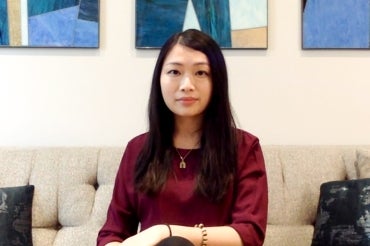U of T librarian creates online resource to fight COVID-19 misinformation

Published: June 26, 2020
In the midst of the pandemic, experts are raising alarms about another public health threat: an “infodemic” of online medical misinformation and disinformation about COVID-19.
In an effort to fight the spread of faulty facts, Vincci Lui, a librarian at the University of Toronto’s Gerstein Science Information Centre, has put together a new online library resource for the U of T community: “How can I spot misinformation about the coronavirus and COVID-19?”
“Everyone’s glued to their phones and looking at things popping up on their newsfeeds,” says Lui, who specializes in bioethics, health policy, and public health.
“It became very apparent that, along with thousands of journal articles coming out every week about COVID-19, some of the reporting on this information is a little incorrect, some is being misinterpreted, some has been taken out of context and some has been misrepresented or made up completely.”
It can be difficult for people to parse the large amounts of new information about COVID-19 coming in every day, according to Lui – especially for those who have little experience in reading medical research in journal articles. That’s why she created a short tip sheet to offer resources for fact-checking and dispelling COVID-19 myths.
The tools include Google’s Fact Check Explorer for COVID and the Coronavirus and the World Health Organization’s Health Alert on WhatsApp. It also offers tips on how to read virus-related social media posts and news articles with a critical eye. For example, the resource page prompts readers to ask whether stories that popped up in their Facebook feeds “use biased or loaded and politicized phrases like ‘Wuhan virus’ or ‘big pharma’?”
Lui created the resource as part of a larger online guide designed as a “one-stop shop” of information resources for U of T researchers, students and faculty members who are studying and doing work around COVID-19.
The guide includes weekly fact-checks addressing common COVID-19 myths and false claims with evidence-based answers.
Misinformation is information that may be rooted in truth but is ultimately incorrect. For example, a newspaper article may inadvertently misinterpret a scientific paper or take its findings out of context. Similarly, findings from faulty scientific studies also continue to be disseminated online long after they have been discredited. There also growing concerns that the traditional safeguards against bad science, such as peer review, are being eroded due to the need for timely results during the COVID-19 pandemic.
Disinformation, by contrast, is information that deliberately misleads people, potentially with a politically motivated goal to sway public opinion. A recent study by Carnegie Mellon University found more than 100 narratives containing false information about COVID-19 – many of them circulated by bots, or automated software programs.
Disinformation can also be spread by sources usually viewed as authoritative, including politicians and world leaders. U.S. President Donald Trump, for example, has been called out by the medical community for numerous false statements about COVID-19, including a suggestion that disinfectant be used through "injection inside or almost a cleaning." While disinfectants can kill viruses on objects and surfaces, injecting or consuming disinfectant, or applying it to skin, can lead to poisoning and death.
Facebook and Twitter posts have also circulated making the extremely dangerous suggestion that people ingest, inject or cover themselves with bleach, which is poisonous if ingested, can cause severe damage to the skin and eyes, and will not protect you against COVID-19. Others have shared conspiracy theories that 5G mobile broadband networks spread COVID-19 ,which, on top of the fact that viruses cannot be spread via radio waves or mobile networks, is proven false by the rate of the COVID-19 spread in countries that do not yet have 5G mobile networks.
A short, conspiracy-laden film called Plandemic: The Hidden Agenda Behind Covid-19 was viewed tens of millions of times on social media before YouTube and Facebook began removing it for violating community guidelines. It, too, has been debunked as disinformation.
“There’s a combination of misinformation – problematic news reporting and misinterpretation of journal articles and scientific studies – along with just outright fake news, information that’s taken as fact and spread, but is just something that someone made up,” says Lui.
Both disinformation and misinformation about COVID-19 are equally problematic, according to Colin Furness, a U of T professor who is cross-appointed with the Institute of Health Policy, Management and Evaluation at the Dalla Lana School of Public Health and the Faculty of Information.
“Both encourage people to engage in behaviours that end up being quite dangerous,” he says. “And it may discourage people from engaging in behaviours needed to keep themselves safe.”
Making matters worse, once a person has consumed COVID-19 misinformation or disinformation, it can become difficult to convince them that it is inaccurate, particularly if they do not have an understanding of public health or how viruses work.
Lui says individuals can help their friends and family members fact-check misinformation and disinformation online.
“Usually whenever I get sent something [about COVID-19], I will then do a quick fact-check and then send the information I find to them and just gently say, ‘Oh, did you see this? Actually, this has been disproven,” she says.
“You’re not going to necessarily convince them just by saying, ‘that’s not true,’ but I try to show them what the evidence is saying.”



